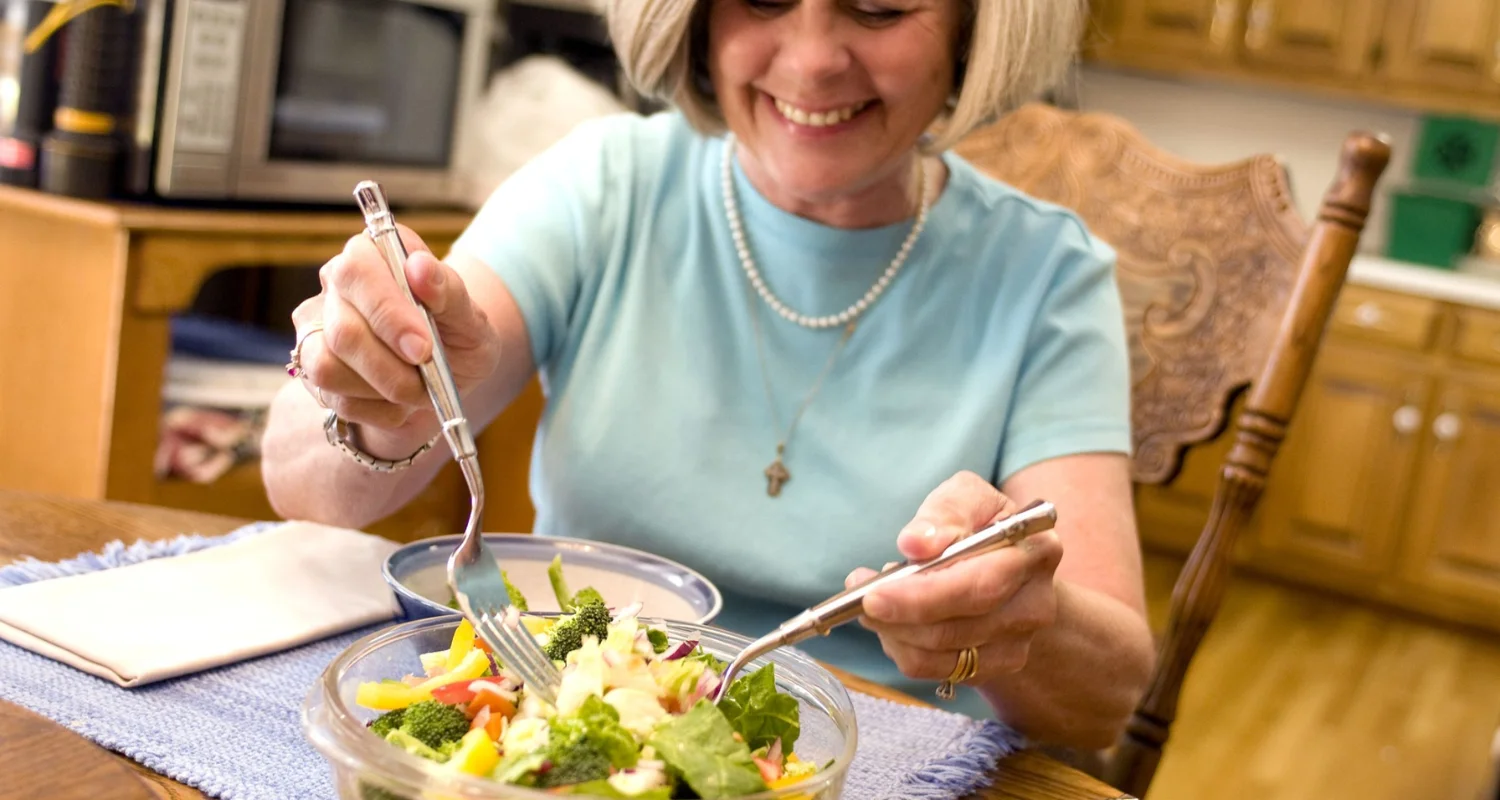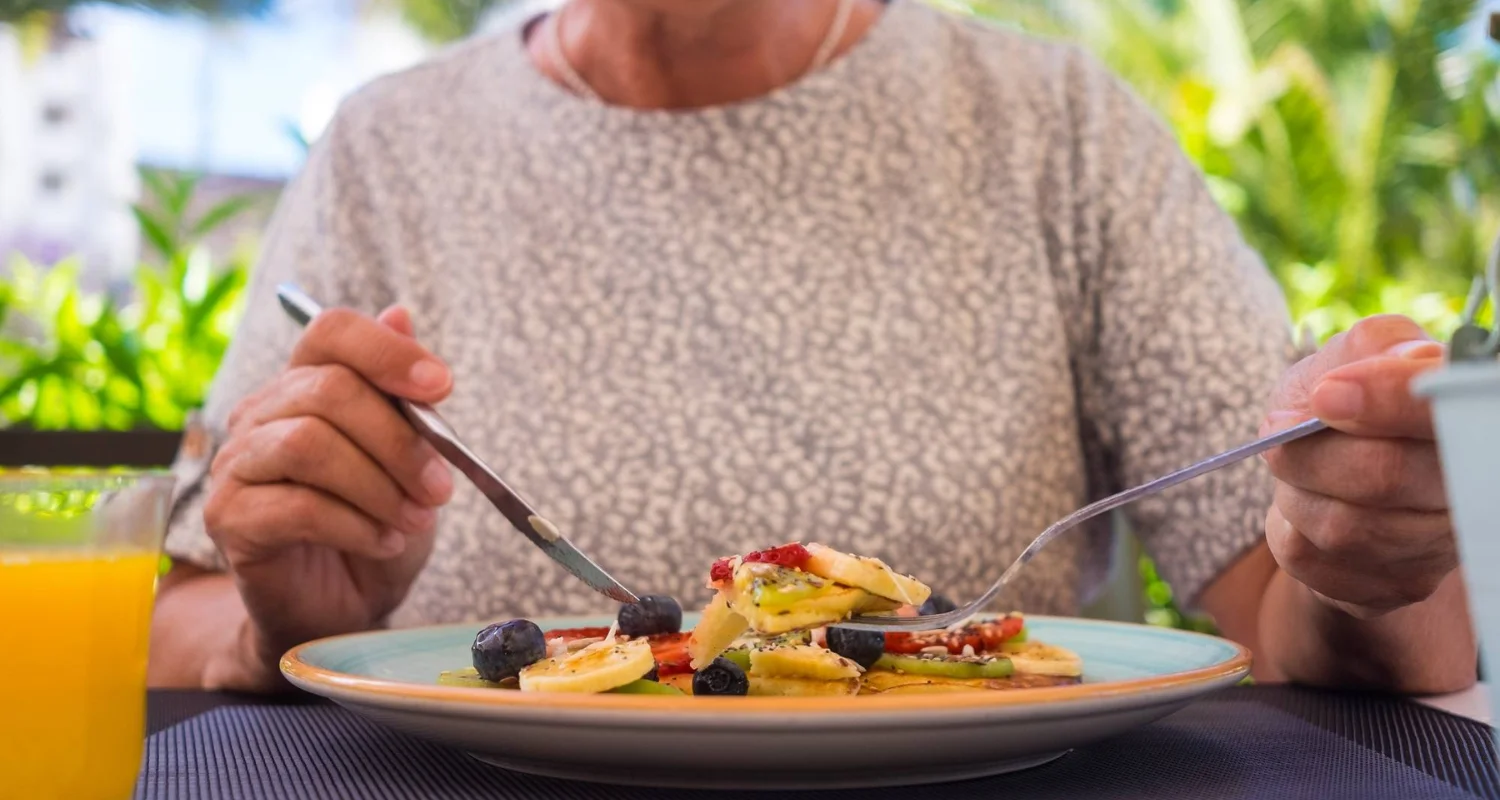Last Updated on: 19th September 2025, 12:35 pm
Are you looking for recipes for soft foods for elderly? You came to the right place!
As we age, maintaining good oral health becomes increasingly important, although it often presents unique challenges. Seniors often face issues such as sensitive teeth, gum discomfort, dentures, or reduced chewing efficiency, making it difficult for them to enjoy a wide variety of foods. These challenges can impact not only oral health, but also overall nutrition and quality of life. Finding the right balance between easy-to-eat, nutrient-dense meals is essential to supporting both dental well-being and overall health.
Soft foods are a vital solution, offering a way to ensure seniors can maintain proper nutrition without discomfort. These foods are gentle on sensitive teeth and gums, while also providing essential vitamins, minerals, and energy to support aging bodies. From creamy soups to pureed vegetables and tender proteins, there are countless ways to create meals that are enjoyable and promote health.
In this article, we’ll explore a variety of oral-health-friendly soft foods tailored to the needs of seniors. Whether you’re a caregiver or looking to improve your own meal choices, you’ll find recipes, preparation tips, and ideas to make eating a pleasure again. Let’s look at practical and delicious ways to ensure seniors can maintain a healthy diet while taking care of their smile and enjoying every bite!
Soft Foods for Elderly: Why are They so Important?
Soft foods for elderly are those foods that require little or no chewing. They should contribute to a nutritious diet for older people when they have difficulty chewing. These include people who have lost this ability because their teeth are very worn or they do not have enough muscle mobility; on the other hand, we can find those people who have undergone dental or jaw surgery that make it difficult to continue a normal diet.
As the years go by, oral problems become more frequent, affecting the ability to enjoy and consume certain foods. The most common problems that older people may present are dental sensitivity, gum disease or the need to use dentures; all of these problems make it difficult to consume large quantities of food, obstructing adherence to an adequate and balanced diet to maintain good dental and general health.
Having a good diet is important for maintaining adequate dental and general health. Hard or crunchy foods can irritate sensitive teeth, inflamed gums or ill-fitting dentures, potentially exacerbating oral health problems. In addition, avoiding foods due to discomfort can lead to nutritional deficiencies, impacting the overall well-being of the senior.
A diet lacking in essential nutrients, such as calcium, vitamin D or protein, can further weaken teeth, gums and bones, creating a cycle of deteriorating oral and overall health. Soft foods are a practical solution, offering nutrition that is gentle on the mouth and easy to consume. Soft foods for elderly ensure that seniors can maintain a balanced diet while minimizing discomfort. Meals prepared with soft, nutrient-rich ingredients allow seniors to enjoy eating without fear of pain or difficulty.
Recipes and Ideas for Soft Foods for Elderly That Improve Oral Health
A diet rich in soft foods is not only great for those facing chewing challenges, but also contributes to maintaining good oral health. Here are easy and nutritious recipes and ideas for every meal of the day, designed to take care of teeth, gums and overall well-being.
Breakfast Ideas for a Gentle Start
1. Smoothie Bowl
● Ingredients: Greek yogurt, blended fruits (banana, berries) and a pinch of oats or chia.
● Oral health benefits: Provides calcium for strong teeth, antioxidants that fight inflammation and avoids added sugars that damage enamel.
2. Scrambled Eggs with Avocado
● Soft and rich in protein, eggs help strengthen teeth and oral tissue.
● Avocado provides healthy fats and vitamin E, essential for gum health.
Nutritious Lunch Recipes
1. Creamy Vegetable Soup
● Recipe: Blend steamed carrots, sweet potatoes, and zucchini with a low-sodium broth, adding a touch of yogurt or milk for extra creaminess.
● Benefits: High levels of vitamins A and C, which support gum repair and oral tissue regeneration.
2. Mashed Sweet Potatoes with Cottage Cheese
● A smooth combination rich in calcium, protein, and fiber. This dish supports healthy teeth and regulates digestion.
Dinner Options for Easy Digestion
1. Baked Salmon with Pureed Peas
● Recipe: Bake salmon with a hint of lemon and mild herbs. Serve with mashed peas.
● Benefits: Omega-3 fatty acids reduce gum inflammation, while mashed peas provide fiber and soft texture.
2. Ground Turkey Meatloaf with Mashed Cauliflower
● Recipe: Mix ground turkey with breadcrumbs, egg, and mild spices. Bake in the oven and serve with cauliflower puree.
● Benefits: Source of lean protein and vitamins K and C to strengthen oral tissues.
Healthy Desserts That Support Oral Health
1. Banana Pudding
● Recipe: Blend ripe bananas with unsweetened almond milk until creamy.
● Benefits: Natural sweetness without enamel-damaging added sugars.
2. Baked Apples with Cinnamon
● Recipe: Soften apple slices in the oven and sprinkle with cinnamon.
● Benefits: Easy to chew, rich in antioxidants, and free of refined sugars.
Hydrating Snacks for Gum Health
1. Yogurt parfaits
● Recipe: Layer Greek yogurt with pureed fruits like mango or strawberries.
● Benefits: Protein and probiotics that support healthy oral flora.
2. Smoothies with added spinach
● Recipe: Blend fruits like pineapple or mango with a handful of fresh spinach and almond milk.
● Benefits: A rich source of vitamins and minerals essential for maintaining healthy gums and strong teeth.
Tips for Preparing Soft Foods for Elderly
Preparing soft foods for elderly requires creativity and a thorough understanding of their needs, ensuring that the food you prepare is nutritious enough, easy to consume and delicious. Here is a detailed list of tips to make preparation easier and enhance the eating experience:
1. Adjust the texture of foods
● Chop and mash: Finely chop foods or mash them into small pieces to make them easier to chew.
● Puree and mash: Use blenders or food processors to turn foods like fruits, vegetables, or meats into smooth textures.
● Hydrate foods: Add milk, broth, or sauces to soften foods like bread, crackers, mashed potatoes, or carrots.
● Cook until tender: Methods like steaming, boiling, or slow cooking achieve smooth textures in vegetables and proteins.
2. Enhance the flavor of bland foods
● Use herbs and spices: Add garlic, ginger, cinnamon or nutmeg to add depth and variety of flavor.
● Sauces and dressings: Add mild sauces such as low-sodium gravy, tomato puree or mushroom sauce to moisten and season.
● Butter and healthy oils: Add butter, salad dressings or oils to enhance flavor and provide healthy calories.
3. Prepare convenient and appealing meals
● Nutritious smoothies: Blend bananas, melons, or frozen fruit with yogurt or milk for an easy-to-eat, nutrient-dense meal.
● Small, frequent meals: Serve smaller portions several times a day to prevent meal fatigue and maintain appetite.
● Use nutrient-rich ingredients:
– Calcium: Yogurt, cheese, and milk to strengthen teeth and bones.
– Vitamin C: Oranges, carrots, and citrus fruits to promote gum health.
– Omega-3: Salmon, flaxseed, and walnuts to reduce inflammation and support overall health.
4. Make eating easier
● Soak dry foods: Soften bread or crackers in milk, tea or soups to make them easier to eat.
● Include easy-to-swallow options: Creamy soups, purees and baby food are ideal for people who have difficulty swallowing.
● Encourage independence: Provide options for seniors to choose and eat food at their own pace.
5. Useful tools for preparing soft foods
● Blenders and food processors: Ideal for achieving the desired consistency in purees and smoothies.
● Adapted utensils: Offers ergonomic cutlery to facilitate food handling if necessary.
6. Presentation and enjoyment
● Make it attractive: Serve foods with vibrant colors and careful presentations to stimulate appetite.
● Vary the options: Offer different combinations of flavors and smooth textures to avoid boredom.
Adopting a diet rich in soft, healthy soft foods for elderly is key to maintaining good oral and overall health. Not only does this approach make meals easier and more enjoyable to consume, it also ensures that older adults get the essential nutrients they need to strengthen their teeth, gums, and bones. Carefully prepared recipes and soft textures can make a big difference in their quality of life, promoting a balanced diet suited to their specific needs.
However, it is also important to be aware of foods to avoid to protect oral health. Hard or sticky foods, such as candy, crunchy chips, and raw carrots, can cause damage to sensitive teeth, irritate gums, or even interfere with dentures. Likewise, acidic and sugary foods, such as soft drinks, pastries, or citrus juices, contribute to enamel wear and promote cavities, a particularly high risk for older adults with more fragile teeth or tooth sensitivity.
Limiting these foods and focusing on nutritious, soft options not only improves oral health, but also reduces the risk of discomfort or dental complications. With the tips and recipes presented, you can create a balanced menu that not only takes care of the smile of seniors, but also allows them to enjoy each meal with confidence and satisfaction. A proper diet with soft foods for elderly t is the foundation of a full and healthy life.
Frequently Asked Questions
What are soft food and mechanical soft food diets?
● Soft food diet: This diet includes foods that are naturally soft or have been modified to be easy to chew and swallow. It’s ideal for seniors with sensitive teeth, gum problems, or difficulty chewing. Examples include pureed soups, mashed potatoes, and yogurt.
● Mechanical soft diet: This diet involves foods that are softened through mechanical means, such as chopping, blending, or pureeing, but do not require full modification. It is suitable for individuals who can tolerate more texture but still need assistance with chewing. Examples include finely chopped meats, steamed vegetables, and tender casseroles.
What are some soft foods for elderly to eat?
Seniors can benefit from a wide range of soft foods that are easy to eat and rich in nutrients:
● Breakfast: scrambled eggs, oatmeal, smoothie bowls with Greek yogurt and blended fruits.
● Lunch: creamy vegetable soups, mashed sweet potatoes with cottage cheese.
● Dinner: baked salmon with pureed peas, turkey meatloaf with mashed cauliflower.
● Snacks: yogurt parfaits with pureed fruits, smoothies with added spinach.
● Desserts: baked apples with cinnamon, banana pudding made with almond milk.
Why should elderly eat soft food?
Soft foods ensure proper nutrition while minimizing discomfort caused by oral health challenges, such as sensitive teeth, gum inflammation, or poorly fitting dentures. They also reduce the risk of choking and help maintain a balanced diet rich in essential nutrients like calcium, vitamin C, and omega-3 fatty acids, which are critical for oral and overall health.
How to cook soft food for the elderly?
● Cook until tender: Steam, boil, or bake vegetables and proteins until they are soft and easy to mash.
● Puree or blend: Use blenders or food processors to create smooth textures for soups, sauces, or desserts.
● Moisten foods: Add broth, milk, or mild sauces to enhance flavor and make foods easier to swallow.
● Incorporate spices and herbs: Use mild seasonings like garlic, cinnamon, or nutmeg to add flavor without irritation.
What are some soft foods that are rich in vitamins?
● Calcium: Yogurt, cottage cheese, and milk.
● Vitamin C: Pureed carrots, steamed broccoli, and orange smoothies.
● Vitamin A: Mashed sweet potatoes, pumpkin puree, and pureed spinach.
● Omega-3: Baked salmon, pureed avocado, and flaxseed in smoothies.
Share
References
1. Diet, Nutrition, and Oral Health in Older Adults: A Review of the Literature. (s. f.). MDPI. downloaded 19 September de 2023, from https://www.researchgate.net/publication/375327150_Diet_Nutrition_and_Oral_Health_in_Older_Adults_A_Review_of_the_Literature
2. Diet quality in a population aged over 65 and related socioeconomic factors. (s. f.). Science Direct. Recuperado 3 de enero de 2021, de https://www.sciencedirect.com/science/article/pii/S021265672030007X
3. Eating concerns. (s. f.). MouthHealthy – Oral Health Information From The ADA. https://www.mouthhealthy.org/nutrition/nutrition-concerns
4. Engelland, S. (2024, 14 June). 17 Healthy Snacks for Seniors | Presbyterian Homes. Presbyterian Homes. https://www.presbyterianhomes.org/blog/healthy-snacks-for-seniors/
5. Ldn, K. D. M. M. R. (2019, 20 June). Healthy eating for older adults. Harvard Health. https://www.health.harvard.edu/blog/healthy-eating-for-older-adults-2019062016868
-
Dr. Yeidy Carolina Mesa [Medical Reviewer]
DDS Yeidy Carolina Mesa Passionate Dentist | Advocate for Accessible Oral Health Education Graduating from Universidad CES in 2022, I am a dedicated general dentist with a lifelong passion for helping others and making a meaningful impact in the world. My journey into dentistry began at the age of 7, inspired by my own experience with braces and overcoming a fear of the dentist. This personal journey shaped my mission to help patients conquer their own dental anxieties and embrace a healthier,...
View all posts





















